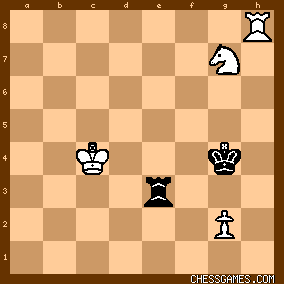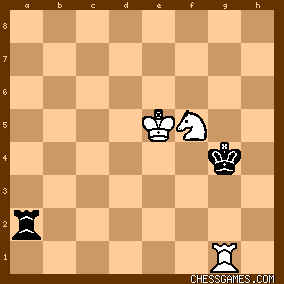|
< Earlier Kibitzing · PAGE 2 OF 2 ·
Later Kibitzing> |
| Jan-20-11 | | Ulhumbrus: Instead of 20...fxe4, 20...f4 starts a King's Indian type pawn storm on the King side. |
|
| Jan-20-11 | | jmboutiere: 26...b5 better than 26...Ne3
30.Ne6 starts the attack against the black king but with a good defence black should be OK |
|
| Jan-20-11 | | jmboutiere: Before the time control Magnus prepares vith 36.Ne6, Rc8 mate!!! Very good for the paychological effect |
|
| Jan-20-11 | | jmboutiere: 37...ef 38.Bd4 Kg8.39.Rc8 wins K
39...Ra2 better than 39...Re1
48...Ne4 49.Kf3 etc after 53...Re1 fokkows 54.Nd3 and white wins |
|
| Jan-20-11 | | jmboutiere: 50...Ne4 better than 50...a2
60...Rd7 is a blunder,better 60...Rd6
62.Bg5 better than 62.Bc1
I love this game. congrat to both payers, especially to Carlsen |
|
| Jan-20-11 | | molinov: No computer will deem 35... Ra3 a mistake. In spite of this, I believe that 35...Rd6 would have secured the draw for black by forcing the exchange of rooks. What do you think? Was L´Ami going for something more here? |
|
Jan-20-11
 | | HeMateMe: Up a pawn me Ami certainly could have drawn. I guess he pressed to hard, and drifted into a lost position. |
|
| Jan-21-11 | | firebyrd: <MC: Later I had planned 72.Rh8 only to discover another stalemate theme and with few seconds left on the clock played Rh2 in desperation letting him off the hook.> Position after 72. Rh8:
click for larger viewWhere is the stalemate theme Magnus is talking about here? |
|
Jan-21-11
 | | beatgiant: <firebyrd>
How about 72. Rh8 Re2 73. Rg8 Rxg2 74. Nf5+ Kh5 75. Rxg2, stalemate. |
|
Jan-21-11
 | | Troller: L'Ami must have been playing for the win just before time control, it's difficult to explain 39..Re1 otherwise. Nicely played then by Magnus, but sort of a tragic ending for the Dutchman. |
|
Jan-21-11
 | | FSR: <bartonlaos> Another R v. R+N: Judit Polgar vs Kasparov, 1996 |
|
| Jan-21-11 | | The Chess Express: Thanks <FSR>, I love this endgame! Unfortunately I have yet to master it. |
|
| Jan-21-11 | | Eyal: Some interesting comments by Dennis Monokroussos on the final stage of the game:
click for larger view<89...Rg3 [89...Rc4 would be my preference. Nowadays the "second rank defense" is all the rage in the R+B vs. R ending, but the old-fashioned Cochrane Defense (http://en.wikipedia.org/wiki/Rook_a...) is also very good, and I think the simplest way to handle the rook and knight vs. rook ending. 90.Rg1+ Kh5 91.Ne7 Rc5+ 92.Nd5 Ra5 creates your basic Cochrane setup, and as long as White's king and rook stay where they are, you maintain it, e.g. 93.Rg2 Rb5 94.Rg8 Ra5 and so on. When the king moves, it must go one way or the other, while keeping the knight protected. When that happens, our king goes the other way. 95.Ke4 Kh6 and when the knight moves, e.g. 96.Nf4 , we've cut White off for a while and can undo even more of his progress with 96...Rg5 , giving our king the freedom to push back off the back rank.] 90.Re1 Rg2 91.Ne7 Kg4 92.Nf5 Ra2 93.Rg1+

click for larger view93...Kf3?? Headed, I guess, for some sort of second-rank like defense, but again, this is more suited to the bishop version of the ending. The problem with second-ranking it is that it works using stalemate tricks, and those stalemate tricks don't work the same when the second piece is a knight rather than a bishop. Suppose, for instance, that the piece on f5 had been a bishop. It might seem that White could win here with 94.Be4+ Ke3 95.Rg3+ followed by 96.Rg2+ and 97.Rxa2. Not so, because after 95.Rg3+ Kf2 96.Rg2+ Ke3!, 97.Rxa2 is stalemate. No such parallel exists with the knight, which is why Black should use a Cochrane-style defense. [93...Kh5 Cochrane!]> (http://www.thechessmind.net/storage...) |
|
| Jan-24-11 | | Albertan: With the assistance of Deep Rybka 4x64, Chessbase 11, Chessbase Megadatabase 2011, the Chessbase online database, and Nalimov endgame tablebases I have analyzed this game and posted this analysis to my blog. A direct link to this analysis is:
http://albertan1956.blogspot.com/20... I hope you drop by and play through this analysis.Endgame tablebases showed that Carlsen blundered in the endgame, which could have permitted L'Ami to draw this game. |
|
| Feb-03-11 | | crazybird: <"I missed the chance of a draw and could barely get out of my chair, I was so upset. Carlsen was fit as a fiddle, as if he still could go run a marathon", Erwin L'ami> |
|
| Jul-01-11 | | supastarr: 72 Rh4+ looks strong, eg Kg5 73 Rd4 Re2 74 g4 Rg2 75 Ne6+ Kf6 76 Re4 |
|
| Sep-20-11 | | freeman8201: Erwin ought to have played his trademark Caro-Kann! |
|
| Jul-20-12 | | master of defence: Where´s the win after 94...Ke3? |
|
| Jul-20-12 | | Alphastar: 95. Rg3, king goes to 2nd row and then 96. Rg2 picks up the black rook. |
|
Jan-22-13
 | | FSR: I had forgotten that Carlsen had pulled off a R+N v. R win in this game. Must have annoyed the hell out of L'Ami to lose that way. |
|
Feb-10-13
 | | Peligroso Patzer: Here are two other games where a solid GM and a world-class GM, respectively, lost this ending:
Onischuk vs L Dominguez, 2008, 0-1 in 91 moves; and
Judit Polgar vs Kasparov, 1996, 0-1 in 90 moves |
|
| Oct-08-17 | | Howard: Seirawan remarked in "Inside Chess" back in 1988 that he was convinced that RN vs R was a draw. Looks like he was somewhat wrong, though they didn't have tablebases back then. |
|
Jan-21-18
 | | FSR: <Howard> R+N v. R is normally a draw. L'Ami blundered. |
|
| Jan-21-18 | | StupidQuestion: <FSR> "L'Ami bad" |
|
Nov-12-18
 | | OBIT: Okay, now that seven-piece tablebases exist, we can see that Carlsen's 72. Rh2? leads to a draw with correct play, as L'Ami managed to do until 93...Kf3?? Instead, Rh4+, Rh6, or Rd5 on move 72 retains a won position. |
|
 |
|
< Earlier Kibitzing · PAGE 2 OF 2 ·
Later Kibitzing> |





